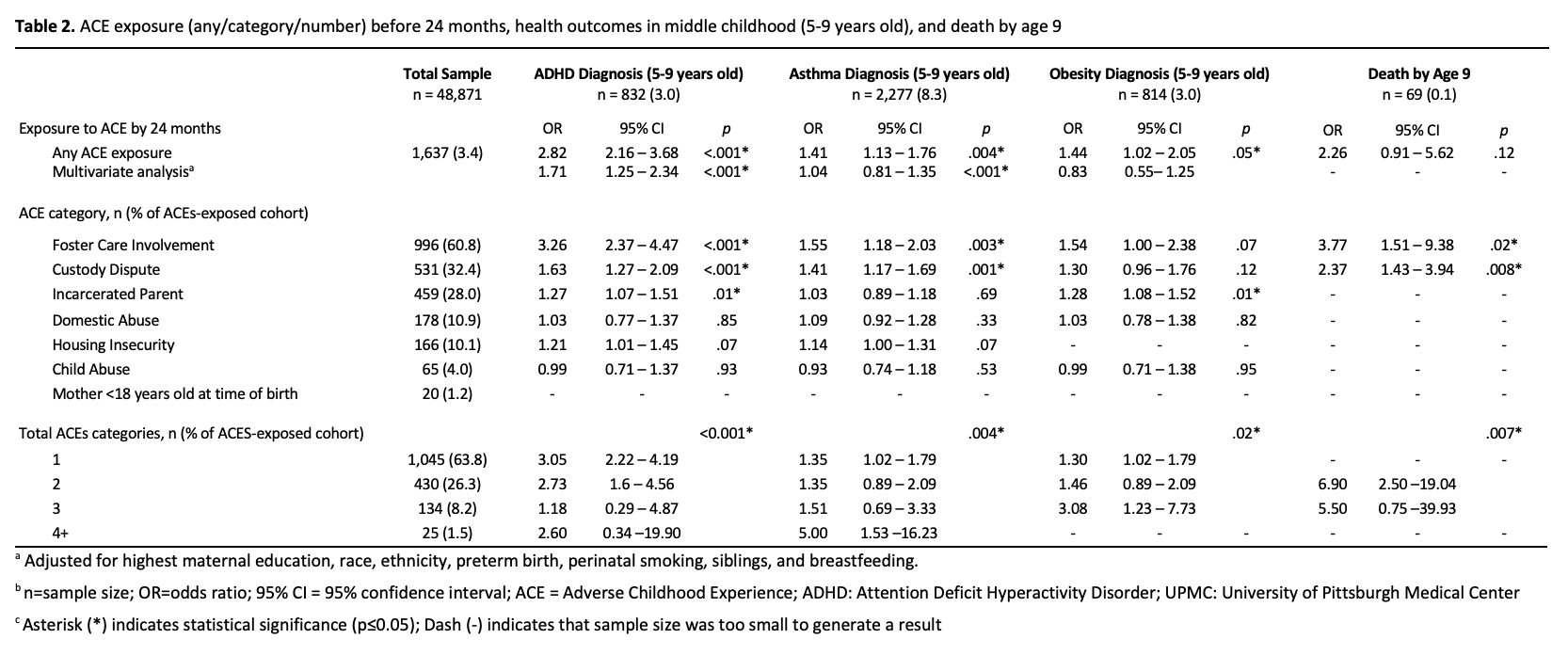Child Abuse & Neglect
Category: Abstract Submission
Child Abuse & Neglect I
212 - Adverse Childhood Events in Infancy and Health Outcomes in Middle Childhood
Monday, April 25, 2022
3:30 PM - 6:00 PM US MT
Poster Number: 212
Publication Number: 212.401
Publication Number: 212.401
Olivia S. Legan, University of Pittsburgh School of Medicine, Pittsburgh, PA, United States; Anne-Marie Rick, University of Pittsburgh School of Medicine, Pittsburgh, PA, United States

Olivia S. Legan
Medical Student
University of Pittsburgh School of Medicine
Pittsburgh, Pennsylvania, United States
Presenting Author(s)
Background: It is well-understood that Adverse Childhood Experiences (ACEs) lead to a multitude of disease states in adulthood. However, the literature relies on retrospective self-reporting of ACEs in adulthood, rather than real-time ACEs detection in the pediatric primary care setting. It also remains unclear when the sequelae of ACEs emerge during childhood, which is key for designing effective interventions.
Objective: To examine if children exposed to ACEs before 24 months of age are as likely as their peers to be diagnosed with ADHD, asthma, and obesity between ages five to nine, or to die before age nine.
Design/Methods: This was a single-center retrospective cohort of infants born from January 1, 2011 to December 31, 2019. Well-child visit notes were searched in the electronic health record and manually reviewed for 21 ACE terms (e.g. abuse, incarcerated). Terms were grouped into six categories: Foster Care Involvement, Custody Disputes, Incarcerated Parent, Domestic Abuse, Child Abuse, Housing Insecurity, and Teen Mother. Health outcomes were identified in the EHR using ICD-9/10 diagnosis codes placed between ages 5-9. Multivariate logistic regression assessed associations between ACE exposure (individual categories and number of categories) and child health outcomes.
Results: Of the 48,871 children included and ~350,000 well-child notes, 1,637 children (3.4%) were identified as ACE-exposed before 24 months of age. 61% were exposed to the foster care system, 32% to custody disputes, 28% to an incarcerated parent, 11% to domestic violence, 10% to housing insecurity, 4% to child abuse, and 1% had a mother < 18 years old at birth. Infants with ≥1 ACE were nearly 3x as likely to receive an ADHD diagnosis (OR:2.8, 95%CI: 2.16-3.68, p< .001), 40% more likely to receive an asthma diagnosis (OR:1.4, 95%CI:1.1–1.8, p=.004), and 40% more likely to receive an obesity diagnosis (OR:1.4, 95%CI:1.02 – 2.1, p=.05) between ages 5-9. After adjusting for confounders, infants with ≥1 ACE were still 70% more likely to receive an ADHD diagnosis (OR:1.7, 95%CI:1.3–2.3, p< .001), but associations with asthma and obesity diagnoses were no longer significant. Although there were only 69 deaths, children with multiple ACEs were 6x as likely to die by age 9 as compared to children with ≤1 ACE (OR:6.4, 95% CI:2.6-16.0, p=.002).Conclusion(s): Our findings highlight not only the feasibility of infant ACEs screening via EHR, but also the urgency of doing so. It is clear that the negative health effects of ACEs are seen as early as middle childhood, emphasizing the importance of early intervention in ACEs-exposed infants and children.
Olivia Legan CVOlivia Legan CV 2022 .pdf
Table 2. ACE exposure (any/category/number) before 24 months, health outcomes in middle childhood (5-9 years old), and death by age 9
Objective: To examine if children exposed to ACEs before 24 months of age are as likely as their peers to be diagnosed with ADHD, asthma, and obesity between ages five to nine, or to die before age nine.
Design/Methods: This was a single-center retrospective cohort of infants born from January 1, 2011 to December 31, 2019. Well-child visit notes were searched in the electronic health record and manually reviewed for 21 ACE terms (e.g. abuse, incarcerated). Terms were grouped into six categories: Foster Care Involvement, Custody Disputes, Incarcerated Parent, Domestic Abuse, Child Abuse, Housing Insecurity, and Teen Mother. Health outcomes were identified in the EHR using ICD-9/10 diagnosis codes placed between ages 5-9. Multivariate logistic regression assessed associations between ACE exposure (individual categories and number of categories) and child health outcomes.
Results: Of the 48,871 children included and ~350,000 well-child notes, 1,637 children (3.4%) were identified as ACE-exposed before 24 months of age. 61% were exposed to the foster care system, 32% to custody disputes, 28% to an incarcerated parent, 11% to domestic violence, 10% to housing insecurity, 4% to child abuse, and 1% had a mother < 18 years old at birth. Infants with ≥1 ACE were nearly 3x as likely to receive an ADHD diagnosis (OR:2.8, 95%CI: 2.16-3.68, p< .001), 40% more likely to receive an asthma diagnosis (OR:1.4, 95%CI:1.1–1.8, p=.004), and 40% more likely to receive an obesity diagnosis (OR:1.4, 95%CI:1.02 – 2.1, p=.05) between ages 5-9. After adjusting for confounders, infants with ≥1 ACE were still 70% more likely to receive an ADHD diagnosis (OR:1.7, 95%CI:1.3–2.3, p< .001), but associations with asthma and obesity diagnoses were no longer significant. Although there were only 69 deaths, children with multiple ACEs were 6x as likely to die by age 9 as compared to children with ≤1 ACE (OR:6.4, 95% CI:2.6-16.0, p=.002).Conclusion(s): Our findings highlight not only the feasibility of infant ACEs screening via EHR, but also the urgency of doing so. It is clear that the negative health effects of ACEs are seen as early as middle childhood, emphasizing the importance of early intervention in ACEs-exposed infants and children.
Olivia Legan CVOlivia Legan CV 2022 .pdf
Table 2. ACE exposure (any/category/number) before 24 months, health outcomes in middle childhood (5-9 years old), and death by age 9

